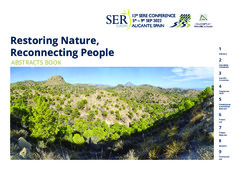Приказ основних података о документу
Vegetation degradation promotes the invasion potential of Impatiens glandulifera in an oligotrophic mountain habitat
| dc.creator | Nikolić, Nina | |
| dc.creator | Stanojević, Miloš | |
| dc.creator | Nikolic, Miroslav | |
| dc.creator | Böcker, R. | |
| dc.creator | Paravinja, Ana | |
| dc.date.accessioned | 2023-09-18T07:50:06Z | |
| dc.date.available | 2023-09-18T07:50:06Z | |
| dc.date.issued | 2022 | |
| dc.identifier.uri | http://rimsi.imsi.bg.ac.rs/handle/123456789/2108 | |
| dc.description.abstract | An annual plant Himalayan balsam (Impatiens glandulifera Royle) is globally widespread and one of the Europe’s well-investigated top invaders. Yet, there is very limited knowledge on the effects of environment on the invasion potential of this species. We focused on two questions: does this species indeed not invade the southern areas of the continent; and, does the environment affect some of its key invasibility traits. In an isolated model valley (Sharr mountain, Western Balkans), we jointly analyzed the soil (21 parameter), the life history traits of the invader (height, stem diameter, aboveground dw), and the resident vegetation (species composition and abundances, Ellenberg indicator values), and supplemented it by the local knowledge (semi-structured interviews). Uncontrolled discharge of fecal wastewaters directly into the local dense hydrological network fostered mass infestation of an atypical, nutrient poor habitat. The phenotypic plasticity of the measured invasion-related traits was very high in the surveyed early invasion (30-50% invader cover) stages. Different microhabitat conditions consistently correlated with its growth performance. The largest individuals were restricted to the deforested riparian habitats with extreme soil nutrient enrichment (primarily by P and K) and low-competitive, species-poor resident vegetation. We showed that ecological context can modify invasion-related traits, what could affect further invasion process. Finally, this species is likely underreported in the wider region; public attitude and loss of traditional ecological knowledge are further management risks. | sr |
| dc.language.iso | en | sr |
| dc.publisher | SER Europe | sr |
| dc.rights | openAccess | sr |
| dc.rights.uri | https://creativecommons.org/licenses/by/4.0/ | |
| dc.source | 13th SERE Conference, Alicante, Spain, September 5-9., 2022 | sr |
| dc.subject | Himalayan balsam | sr |
| dc.subject | invasive alien species | sr |
| dc.subject | soil nutrient enrichment | sr |
| dc.subject | henotypic plasticity | sr |
| dc.subject | Western Balkans | sr |
| dc.title | Vegetation degradation promotes the invasion potential of Impatiens glandulifera in an oligotrophic mountain habitat | sr |
| dc.type | conferenceObject | sr |
| dc.rights.license | BY | sr |
| dc.citation.spage | 161 | |
| dc.identifier.fulltext | http://rimsi.imsi.bg.ac.rs/bitstream/id/5592/bitstream_5592.pdf | |
| dc.identifier.rcub | https://hdl.handle.net/21.15107/rcub_rimsi_2108 | |
| dc.type.version | publishedVersion | sr |

